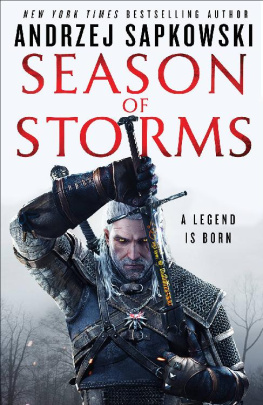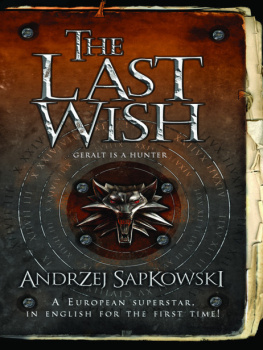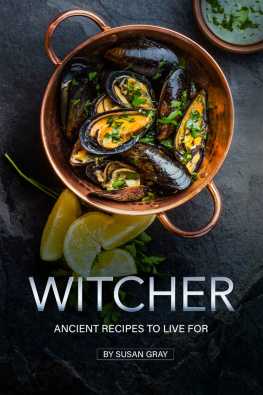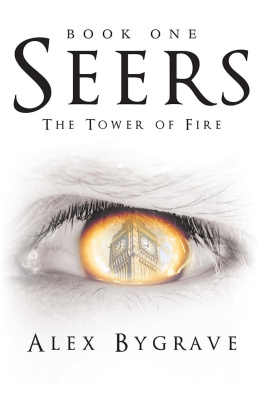A beggars song about the frightful massacre which took place in Dun Dre on Samhain Eve
I can give you everything you desire, said the fortune-teller. Riches, power and influence, fame and a long and happy life. Choose.
I wish for neither riches nor fame, neither power nor influence, rejoined the witcher girl. I wish for a horse, as black and swift as a nightly gale. I wish for a sword, as bright and keen as a moonbeam. I wish to overstride the world on my black horse through the black night. I wish to smite the forces of Evil and Darkness with my luminous blade. This I would have.
I shall give you a horse, blacker than the night and fleeter than a nightly gale, vowed the fortune-teller. I shall give you a sword, brighter and keener than a moonbeam. But you demand much, witcher girl, thus you must pay me dearly.
With what? For I have nothing.
With your blood.
Flourens Delannoy, Fairy Tales and Stories
CHAPTER ONE
As is generally known, the Universelike lifedescribes a wheel. A wheel on whose rim eight magical points are etched, making a complete turn; the annual cycle. These points, lying on the rim in pairs directly opposite each other, include Imbolc, or Budding; Lughnasadh, or Mellowing; Beltane, or Blooming; and Samhain, or Dying. Also marked on the wheel are the two Solstices, the winter one called Midinvaerne and Midate, for the summer. There are also the two EquinoxesBirke, in spring, and Velen, in autumn. These dates divide the circle into eight partsand so in the elven calendar the year is also divided up like that.
When they landed on the beaches in the vicinity of the Yaruga and the Pontar, people brought with them their own calendar, based on the moon, which divided the year into twelve months, giving the farmers annual working cyclefrom the beginning, with the markers in January, until the end, when the frost turns the sod into a hard lump. But although people divided up the year and reckoned dates differently, they accepted the elven wheel and the eight points around its rim. Adopted from the elven calendar, Imbolc and Lughnasadh, Samhain and Beltane, both Solstices and both Equinoxes became important holidays, sacred tides for human folk. They stood out from the other dates as a lone tree stands out in a meadow.
Those dates are also set apart by magic.
It was notand is nota secret that the eight dates are days and nights during which the enchanted aura is greatly intensified. No longer is anyone astonished by the magical phenomena and mysterious occurrences that accompany the eight dates, in particular the Equinoxes and Solstices. Everyone is now accustomed to such phenomena and they seldom evoke a great sensation.
But that year it was different.
That year people had, as usual, celebrated the autumnal Equinox with a solemn family meal, during which all the kinds of fruits from that years harvest had to be arrayed on the table, even if only a little of each. Custom dictated it. Having eaten and given thanks to the goddess Melitele for the harvest, the people retired for the night. And then the nightmare began.
Just before midnight a frightful storm got up and a hellish gale blew, in which a ghastly howling, screaming and wailing were heard above the rustling of trees being bent almost to the ground, the creaking of rafters and the banging of shutters. The clouds driven across the sky assumed outlandish shapes, among which the most common were silhouettes of galloping horses and unicorns. The gale did not abate for a good hour, and in the sudden silence that followed it the night came alive with the trilling and whirring of the wings of hundreds of goatsucker nightjars, those mysterious fowl whichaccording to folk talesgather together to sing a demonic death knell over a dying person. This time the chorus of nightjars was as mighty and loud as if the entire world were about to expire.
The nightjars sang their death knell in clamorous voices while the horizon became shrouded in clouds, quenching the remains of the moonlight. At that moment sounded the howl of the fell beannshie, the harbinger of imminent and violent death, and across the black sky galloped the Wild Hunta procession of fiery-eyed phantoms on skeleton horses, their tattered cloaks and standards fluttering behind them. So it was every few years. The Wild Hunt gathered its harvest, but it had not been this terrible for decadesin Novigrad alone over two dozen people went missing without a trace.
After the Hunt had galloped by and the clouds had dispersed, people saw the moonon the wane, as was customary during the Equinox. But that night the moon was the colour of blood.
Simple folk had many explanations for these equinoctial phenomena, which tended to differ considerably from each other according to the specifics of local demonology. Astrologers, druids and sorcerers also had their explanations, but they were in the main erroneous and cobbled together haphazardly. Few, very few, people were able to connect the phenomena to real facts.
On the Isles of Skellige, for example, a few very superstitious people saw in the curious events a harbinger of Tedd Deireadh, the end of the world, preceded by Ragh nar Roog, the last battle between Light and Darkness. The violent storm which rocked the Islands on the night of the Autumn Equinox was regarded by the superstitious as a wave pushed by the prow of the fearsome Naglfar of Morhgg, a longship with sides built of dead mens fingernails and toenails, bearing an army of spectres and demons of Chaos. More enlightened or better informed people, however, linked the turmoil of the heavens with the evil witch Yennefer, and her dreadful death. Others yetwho were even better informedsaw in the churned-up sea a sign that someone was dying, someone in whose veins flowed the blood of the kings of Skellige and Cintra.
The world over, the autumn Equinox was a night of spectres, nightmares and apparitions, a night of sudden, suffocating awakenings, fraught with menace, among sweat-soaked and rumpled sheets. Neither did the most illustrious escape the apparitions and awakenings; Emperor Emhyr var Emreis awoke with a cry in the Golden Towers in Nilfgaard. In the North, in Lan Exeter, King Esterad Thyssen leaped from his bed, waking his spouse, Queen Zuleyka. In Tretogor, the arch-spy Dijkstra leaped up and reached for his dagger, waking the wife of the state treasurer. In the huge castle of Montecalvo the sorceress Philippa Eilhart leaped from damask sheets, without waking the Comte de Noailles wife. The dwarf Yarpen Zigrin in Mahakam, the old witcher Vesemir in the mountain stronghold of Kaer Morhen, the bank clerk Fabio Sachs in the city of Gors Velen and Yarl Crach an Craite on board the longboat Ringhorn all awoke more or less abruptly. The sorceress Fringilla Vigo came awake in Beauclair Castle, as did the priestess Sigrdrifa of the temple of the goddess Freyja on the island of Hindarsfjall. Daniel Etcheverry, Count of Garramone, awoke in the besieged fortress of Maribor. As did Zyvik, decurion of the Dun Banner, in Ban Gleann fort. And the merchant Dominik Bombastus Houvenaghel in the town of Claremont. And many, many others.









